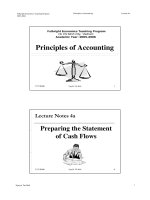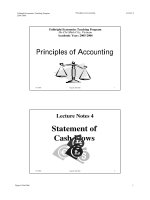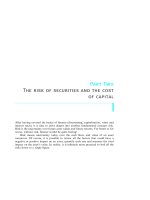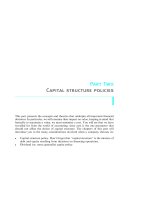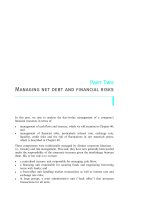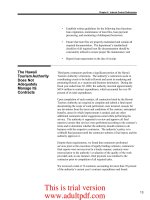chapter 2 project cash flows
Bạn đang xem bản rút gọn của tài liệu. Xem và tải ngay bản đầy đủ của tài liệu tại đây (393 KB, 11 trang )
1
Chapter 2: Project Cash
Flows
The definition, identification, and
measurement of cash flows
relevant to project evaluation.
2
Why Cash Flows?
Cash flows, and not accounting
estimates, are used in project
analysis because:-
1. They measure actual economic
wealth.
2. They occur at identifiable time points.
3. They have identifiable directional flow.
4. They are free of accounting
definitional problems.
3
The Meaning of RELEVANT
Cash Flows.
A relevant cash flow is one which
will change as a direct result of the
decision about a project.
A relevant cash flow is one which will
occur in the future. A cash flow
incurred in the past is irrelevant. It is
sunk.
A relevant cash flow is the difference
in the firm’s cash flows with the project,
and without the project.
4
Cash Flows: A Rose By Any
Other Name Is Just as Sweet.
Relevant cash flows are also
known as:-
Marginal cash flows.
Incremental cash flows.
Changing cash flows.
Project cash flows.
5
Project Cash Flows:
Yes and No.
YES:- these are relevant cash flows -
Incremental future sales revenue.
Incremental future production costs.
Incremental initial outlay.
Incremental future salvage value.
Incremental working capital outlay.
Incremental future taxes.
6
Project Cash Flows:
Yes and No.
NO:- these are not relevant cash flows -
Changed future depreciation.
Reallocated overhead costs.
Adjusted future accounting profit.
The cost of unused idle capacity.
Outlays incurred in the past.
7
Cash Flows and Depreciation:
Always A Problem.
Depreciation is NOT a cash flow.
Depreciation is simply the accounting
amortization of an initial capital cost.
Depreciation amounts are only
accounting journal entries.
Depreciation is measured in project
analysis only because it reduces
taxes.
8
Other Cash Flow Issues.
Tax payable: if the project changes tax
liabilities, those changed taxes are a
flow of the project.
Investment allowance: if a taxing
authority offers this ‘extra depreciation’
concession, then its tax savings are
included.
Financing flows: interest paid on
debt, and dividends paid on equity, are
NOT cash flows of the project.
9
Other Cash Flow Issues.
In property investment, ‘property’ cash
flows may be distinguished from
‘equity’ cash flows.
In project analysis, cash inflows
are timed as at the end of a year, and
capital outlays are timed as at the
start of a year.
Forecast inflated cash flows must be
discounted at the nominal discount
rate, not the real discount rate.
10
Using Cash Flows
All relevant project cash flows are set
out in a table.
The cash flow table usually reads
across in End Of Years, starting at EOY 0
(now) and ending at the project’s last
year.
The cash flow table usually reads down
in cash flow elements, resulting in a Net
Annual Cash Flow. This flow will have a
positive or negative sign.
11
Project Cash Flows: Summary
Only future, incremental, cash flows
are Relevant.
Relevant Cash Flows are entered
into a yearly cash flow table.
Net Annual Cash Flows are
discounted to give the project’s Net
Present Value.
